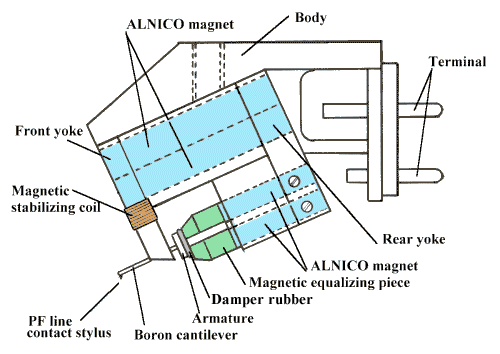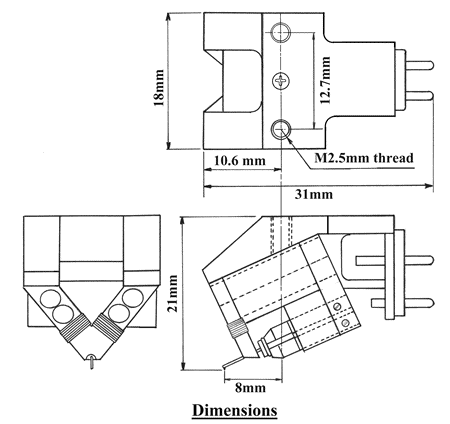Dynavector XV1-t MC Phono Cartridge (NEW!!)
R108,000.00
Introductory SPECIAL!
Only ONE available
![[Dynavector DRT XV-1t]](https://www.tnt-audio.com/gif/dynavector-xv1t.gif)
Introduction
Forgive me because now we’re going to have on of my rambling introductions.
The DRT-1t is Dynavector’s new flagship cartridge. Regular readers will know that I’ve reviewed and been a long term user of it’s predecessors (both still in production) the DRT-1 and DRT-1s, each a hideously expensive piece of kit designed to push back the limits of analogue sound. Well the DRT-1t is insanely expensive. I know there are still more expensive cartridges out there, but when I tell you that the beast is more expensive than the Feickert turntable and SME V12 arm that I’m using for the test – combined – you can see what I mean.
This arms race of super cartridges has now reached stratospheric levels and the worst part is that you don’t buy a cartridge and forget it – no, if you use it as intended you are merely getting the use of it for maybe a 1000 hours or so before it begins to lose its edge.
This means that such cartridges are not for the sort of audiophile who’s prepared to save and save to buy a component at the limit of their budget in order to satisfy their hobby (like me) – no it means that only the wealthy need apply – these cartridges are for the people who go out and spend £100,000 on a turntable, maybe the same of speakers and amps.
So what is the point of putting such a cartridge in my ‘little’ system?
Curiosity… You see I believe hi-fi is very like tuning a car engine. When you tune an engine you are in essence trying to get as much air/fuel mix into the motor, burn it and then it out of the exhaust. Bigger engines produce more power because they suck and blow bigger volumes of air/fuel. High revving engines produce more power because the suck more air/fuel in faster and blow more exhaust gas out. I’ve just spent a fortune on my Elise motor having the head flowed so more air/fuel goes in/out and so on. However if at any point that flow is restricted it doesn’t matter how good the rest of the flow is, it will lose power because of that bottleneck. So that mighty 500 bhp V8 can be crippled by an air filter too restricted, or by and inlet manifold with sharp curves, or a small exhaust – you get the idea. A ‘bottleneck’ anywhere will severely restrict the performance of the rest of the engine no matter how good it is.
I consider the art of hi-fi to be similar. Some have argued that the front end of a system is the dominant element ‘rubbish in rubbish out’, but I beg to differ. In my experience a great front end can be made to sound very ordinary when partnered with limited components elsewhere – a bottleneck anywhere will cripple the sound, my hi-fi adventures have had the advantage of allowing me to try a huge range of components, often well beyond my means and yet the system I now sit in front of is not only supremely satisfying for me, it is also balanced both in sound quality, and almost by coincidence by the price of the components involved. The front end of Dr Feickert Woodpecker/SME V-12 cost much the same as the Ayon Audio Crossfire, and my precious Loth-x Polaris would be in the same ballpark if they were still available.
I suppose you could say that the DRT-1t fits the pattern but for it’s life span, but as I’ve mentioned my system is not it’s natural home… What intrigues me is whether the cartridge is a potential bottleneck. As changing a cartridge – especially as I use a Dynavector Karat 17D3 as my regular cartridge – is unlikely to unbalance the system in the way a major change to amp or most frequently speakers can do, I jumped at the opportunity.
So if Dynavector are happy to loan one – why not!?
Construction
Forgive me but I’ll send you to the previous reviews of the DRT-1 and DRT-1s for much of this. The DRT-1t looks very similar, the most obvious difference being the body of “Urushi lacquered over a precision machined component of heat treated bamboo” replacing the acrylic and ebony of the lesser brethren. Beyond this the Armature and windings are quite different.
In Use
Dynavector’s own phono stages and step-ups are current amplifying, and for the test I used both their own step-up and my own ESE Nibiru stage – again current amplifying and in the past a fine match for the other Dynavectors I’ve had here – and the best sounding stage I’ve heard.. The rest of the system I’ve mentioned. The SME V12 is a perfect match (and even on those £100,000 turntables would be tough to beat) and one of the easiest arms to optimise set-up.
The DRT-1t comes in a very pretty wooden jewel box, and with a solid stylus guard – though as with almost any cartridge I find the time of maximum danger the moment I fit or remove the damn thing – only the simple Shure V15 drop-down guard has proved anything other than liability in this household – indeed the only cartridge I’ve ever wiped the stylus off was a Dynavector whilst trying to fit the bloody guard!
But with the guard removed and disposed of fitting the cartridge was easy – the body is ‘square’ at the top for basic alignment, and the threaded body makes things less accident prone. The cantilever is terrifyingly exposed, jutting out nearly a cm from the body, but this also greatly simplifies alignment – hell if you can afford eight grand for a cartridge you can afford the odd mishap 🙂
As always set-up is critical and I spend more time than healthy fiddling with alignment and I have to say the DRT-1t didn’t seem unduly fussy, my only observation being that it seemed to like more VTF than recommended by Dynavector, and I settled for a quite heavy 2.6 grms in the end.
Sound Quality
Bugger…
My hope was that the DRT-1t would be very nice, maybe a tadge better than the DRT-1s but really not a fundamental change from the 17D – a cartridge that always seems to punch over its weight and rarely gets it wrong. Well no… The DRT-1t, stone-cold and shiny new – not broken in – made a crushing statement the second it hit the first bit of vinyl I placed on the platter.
First the surface noise was lower, quite noticeable so – not always what you get with a sophisticated cartridge, sounding much darker with what clicks there were simply not catching your ear and totally disassociated from the music once it started to play.
Running the cartridge in increased its lead, but here’s my attempt at describing what I’m hearing.
First off it’s not possible to isolate one attribute. The immediate impact is of a bigger more open soundstage and an utter lack of any hint of grain. The openness was a clear step ahead of its predecessors even on some very old vinyl I dug out. Right now I’ve some Wishbone Ash on the platter, a disc I bought 30 years ago and the Dynavector is making it sound new. With 1500 records here – most of them past their prime this is a precious attribute. I saw the band live in 1979 and I’m in danger of a case of tearful nostalgia so I’d better move on…
‘Nothing is perfect’ I hear you cry, but honest guys (and gals if there are any) what do you say when something is so seamless and integrated from top to bottom. It’s just so incredibly musical – if anything you could think it was slightly sugared, and then you’ll put of some Kurt Cobain and it shreds the air like a knife. When I tested the DRT-1s I wondered if it was possible to drag anything else from the vynil groove – now I’m asking that question again.
I suppose the easiest thing is to say what it isn’t… It isn’t a cartridge that searches out detail and pushes it at you. I compared it to several cartridges in the £500 – £1500 range and the DRT-1t didn’t miss anything that they produced – even the detail hound that is the Music Maker, but everything was presented in a delightfully integrated way. If you like that leading edge/hyper info sound then there are cheaper cartridges that will fit the bill – Audio Technicas at a fraction the price for one, and in the Dynavector stable the 17D misses very little. But the DRT-1t pulls at least as much detail, and presents it in the the context of a musical event placing these small details in their own particular space rather than, for example, hearing a ‘ting’ from the left hand tweeter. The control of detail in the soundstage is rock solid and continues regardless of the complexity, or the level of the track – perhaps it’s this absolute, unwavering solidity of the music presented in front of you in a realistic 3d soundstage that is the most outstanding characteristic, and the one that makes the ‘suspension of belief’ necessary to forget that you are listening to a recording so much easier to maintain, it’s also the thing most difficult to describe in a review. Oh how much easier to whitter on about the resin on the bowsstring of Yehudi Menuhin’s Stradivarious and how it was obvious the recording was done in a more humid room than normal because of the tambre of the tympany – all that stuff relies on the fertile imagination of reviewers and systems that will pick out particular details. The DRT-1t isn’t like this, it produces an orchestra, not the clatter of a clarinettist’s keys…
Just a couple of examples…
One of my favourite test LP’s is an old copy of the 2001 soundtrack – the first track being of course ‘Also Sprach Zarathustra ‘. performed by the Vienna Philharmonic Orchestra conducted by Herbert von Karajan. The opening is a hair-on-the-back-of-the-neck moment as the drone of a long organ pipe fills the room and rattles the window (forgive my ignorance on which it is, but I suspect 16 foot which is 32 Hz, but possibly lower). Few systems do this properly, frequently degenerating into a throbbing mess or just ignoring the fundamentals altogether (which is preferable!). The slowly swelling brass which comes from this foundation rises to an ear splitting crescendo and needs to have real bite and edge to work well. This very demanding cut usually result in the soundstage narrowing towards the centre as the level rises, lesser cartridges collapsing into Mono – Until now I suspected that part of this was down to the limitations of vinyl – I was wrong…
Then last night I sat captivated as Joni Mitchel sang ‘Blue’, the slight ‘popping’ of the mike, the octave jumps, the huge range from little girl to baritone, it’s an evil track, cut at the centre of the disk and my copy is well used over the last 25 years – flawless.
And so it continues – I tried record after record and each just seemed to give their all, but with an uncanny realism, even Polly Styrene singing ‘Bondage Up Yours!’ seemed to have some hi-fi attributes to go with the manic energy. I could go on about all the discs I’ve listened to over the last month, but simply put, none have ever sounded as good, and never did the cartridge put a foot wrong, some disks really surprising me with what could be dragged from their surface. No cartridge has ever made such utterly natural music in my home. Believe me, I’ve tried very, very hard to trip the thing up, but I’ve failed.
You get the idea.
Conclusion
The DRT-1t isn’t a revolutionary design, it’s a refinement of the original DRT-1 with the devil being in the detail, and there’s no question that it took the strengths of that design and built on them. The idea that the cartridge can be a bottleneck even in my lower high-end system (whatever that means) is something I had suspected, but I’d not expected it to be quite such an improvement. I’ll say it again – this cartridge is both insanely expensive and as with all cartridges will have a limited life span, but in my system the difference it made over a fine £1000 cartridge was of the order of swapping a good £2000 amp for an £8000 single-ended amp. For those lucky audiophiles who can afford £100,000+ systems the difference may well be far more significant, that bottleneck all the more evident, and to buy something less exotic would be seling that investment short. But value judgements are irrelevant here, simply because if you need to consider value then you can’t afford it. Some people will tell you that it’s all a con, that much cheaper cartridges are at least as good, but that’s not my experience. If cartridges lasted forever I could easily justify it’s cost in a system like mine, but the on-going servicing costs (even with the exchange system offered by Dynavector) preclude all but the seriously wealthy, or seriously obsessed from applying; after all if you are willing to invest this sort of money into a vinyl system then it’s going to get used a lot.
Pierre Lurne once said to me once that a normal transistor radio will give you 90% of available fidelity. You’ll hear the lyrics, the tune, follow a bass line and have fun – it’s something we forget too easily. Hi-fi is left fighting over the last 10%, the extreme high-end is left with the last 1 or 2%, how on earth can such slicing of the difference between the recording and reality be so important? I just don’t know…
Riding High with the Dynavector DRT XV-1t
by Marc Mickelson | May 22, 2012
|
|
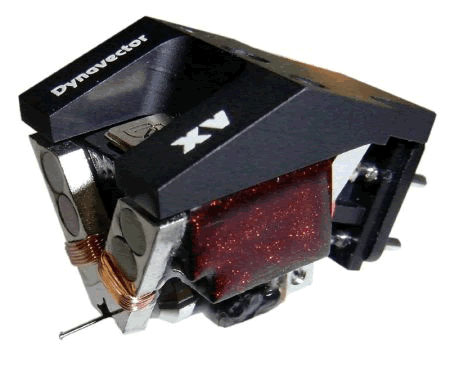 riting audio reviews (and running an audio-review website) can have its moments — in between days, weeks and months on the publishing treadmill. My most recent “moment” happened without a hint that it was coming. I needed to send my Dynavector XV-1s cartridge back to its maker in Japan to be inspected, as its body was riding low, unnervingly close to the record surface. The “moment” came after the cartridge was mailed to Mike Pranka, Dynavector’s US distributor, who would forward it to Japan. About two weeks after I sent the cartridge, Mike e-mailed me to propose something that would make any sane owner of an XV-1s blurt out “Yes!” without a moment of thought: “Let me know if you’d like to give a ‘1t demo unit a listen.” “A ‘1t” referred to Dynavector’s top-of-the-line DRT XV-1t cartridge, which I had heard a few times at shows — as part of unknown systems in unfamiliar rooms, an entirely inadequate situation for evaluating a $9250 phono cartridge. I’m always mystified when someone claims to hear past the rest of a demo system to glorify a CD player or preamp — an illogical assertion to be sure.
riting audio reviews (and running an audio-review website) can have its moments — in between days, weeks and months on the publishing treadmill. My most recent “moment” happened without a hint that it was coming. I needed to send my Dynavector XV-1s cartridge back to its maker in Japan to be inspected, as its body was riding low, unnervingly close to the record surface. The “moment” came after the cartridge was mailed to Mike Pranka, Dynavector’s US distributor, who would forward it to Japan. About two weeks after I sent the cartridge, Mike e-mailed me to propose something that would make any sane owner of an XV-1s blurt out “Yes!” without a moment of thought: “Let me know if you’d like to give a ‘1t demo unit a listen.” “A ‘1t” referred to Dynavector’s top-of-the-line DRT XV-1t cartridge, which I had heard a few times at shows — as part of unknown systems in unfamiliar rooms, an entirely inadequate situation for evaluating a $9250 phono cartridge. I’m always mystified when someone claims to hear past the rest of a demo system to glorify a CD player or preamp — an illogical assertion to be sure.
When the cartridge arrived, I was anxious to mount it (hold your giggles) but held my breath as I removed it from its wooden box and cautiously affixed it to the headshell of my Tri-Planar tonearm. The ‘1s and ‘1t share a feature that seems meant to raise caution, just like bright colors on a jungle frog’s back. Its cantilever juts off the front like a diving board, making it all the easier to snap off with a ham-handed move. I’ve been fortunate with my ‘1s, mounting and unmounting it several times without incident, but such successes breed confidence in the foolhardy. I took it slow and had the ‘1t playing, if not precisely dialed in, within an hour.
The ‘1t retains many of the design specifics of the ‘1s, including powerful Alnico magnets, a boron cantilever and a line-contact stylus that is so tiny it almost looks like it’s missing. The main differences are the shape of the ‘1t’s armature — which is square — the 16-micron coil windings, and the cartridge’s body, which is fashioned from bamboo and then sealed in Urushi lacquer, which gives it a blood-red hue and surely changes its resonance properties. Outwardly, all of these fall under the category of refinements, given that the ‘1s and ‘1t have so much in common — the similarities between the two are easy to see. The ‘1t has slightly higher output, 0.35mV versus 0.30 for the ‘1s, and it’s half a gram lighter. The ‘1t’s higher internal impedance requires higher loading, but other than that, it’s a drop-in replacement for — or should I say, a cautiously handled alternative to — the ‘1s.
Paul Bolin, who also owns an XV-1s, hit it on the head when he described it as being halfway between a Clearaudio and a Koetsu, and the ‘1t resides on this same plane. That’s a quick way of saying that there is no obvious tonal variation from one cartridge to the other, the ‘1t retaining the fundamental balance and “Dynavectorness” that are the ‘1s’s greatest assets. Still, the ‘1t showed slightly more sparkle in the treble — not a shift toward that region, but better capturing of fine detail. Bass tautness and impact were also better, the ‘1t sounding more visceral and defined down low. Most notable was the way it spread and layered the soundstage — in discrete vectors defined by the musicians and singers that occupied them — and unraveled each recording, not analytically parsing the music but illuminating it and better differentiating each recording. “It’s truthful, beautiful and seductive all at once,” I wrote Mike Pranka after an especially long listen, and that sums up the appeal of Dynavector cartridges to begin with.
I don’t have to ask rhetorically if the ‘1t is better than the ‘1s. It is, the only pain with the gain being the difference in price — the XV-1s is currently $5450. The more important question, and the one I’ll ask, is: Are the gains worth the extra money? I’m not going to cop out by saying “That’s up to you and your bank account, blah, blah, blah.” When you consider what $3800 can buy in terms of sonic improvement — often different, not definitively better — the ‘1t makes its case clearly and unambiguously.
The greatest obstacle to purchase may be getting to hear the ‘1t. I would guess there aren’t many dealers with it mounted and ready for demonstration. But if you are a ‘1s owner who is considering the ‘1t as a replacement or upgrade, you can be assured that everything you like about your cartridge is retained and there are meaningful sonic embellishments as well. The ‘1t is both the same and better.![]()
Dynavector Drt Xv 1t (£5500)
Its boron cantilever is fitted with an exquisite line contact diamond and its generator features multiple, flux-damped Alnico magnets. Enter the latest Dynavector flagship
Outstanding hi-fi products have never been designed by committee. They nearly always originate in the mind of one very gifted individual, like the late Dr Noboru Tominari.
Dr Tominari was a professor of engineering at Tokyo State University when he launched the Dynavector company in 1975. He developed the first successful high-output moving-coil, which did not need a special step-up device but worked with the moving-magnet phono input that was then standard on every hi-fi amplifier.
The early Ultimo 10x, which was so popular in the UK in the late 1970s, was the ancestor of the today’s high-output Dynavector 10X5.
LITTLE GEM
Later, Dr Tominari was the first to offer a cartridge with a solid gemstone cantilever, when Dynavector launched the Karat series. But his final contribution to the art and science of cartridge design was the XV-1, along with its successor, the XV-1s of 1999. This did not use the Karat type of short gemstone cantilever, but did offer a newly-designed generator system.
After Dr Tominari passed away in 2002, the process of development and refinement continued for a few more years, until the company was finally ready to unleash the XV-1t, reviewed here. When the enticing walnut box arrived, I couldn’t wait to try it, but made myself spend the time carefully setting it up on the SME 10 before I sat down to listen.
SHEER CLARITY
Rounding up the usual suspects, I started with Rob Wasserman’s Duets [GRP 97 121]. Jennifer Warnes’ ‘Ballad Of The Runaway Horse’ vocal was delivered with a lovely presentation and true delicacy, the tiny breath sounds well captured.
Imagery was well-centred and precise, with a real sense of distance to the background vocals. But on this track I was also immediately struck by the Dynavector’s bottom-end abilities, as Rob Wasserman’s bass had a plangent, well-sprung quality.
To wake things up a bit I put on Eric Clapton’s ‘Motherless Children’ from 461 Ocean Boulevard [RSO 2479 118]. Here the bass was impressive, good and tight, the drum sound really punchy and clear. Clapton’s vocal here must be one of his most passionate efforts, and the processing of the voice was quite clearly delivered, making me more aware than ever how much treatment and processing had gone into that vocal.
Actually the XV-1t was so analytical that it almost seemed at times as if I were hearing just the effects, not the voice itself. If you chose to listen to the multiple guitars, the fantastic clarity of the XV-1t allowed you to focus at will on any of them, and I found myself picking out a little overdriven chunk-a-chunk rhythm part that usually goes unnoticed.
Again, clarity was the word that sprang to mind first when I put on Dire Straits [Vertigo 9102 021]. Knopfler’s lead guitar actually sounded slightly more prominent than usual, perhaps because it was so clearly separated in the mix. There was a fine, wide soundstage, with the rhythm guitars well delivered and clear.
Moving on to The King James Version [Sheffield Lab LAB-3], I found that there was a nicely snarly sound to the brass generally, while Harry James’ solo on ‘Corner Pocket’ sounded natural and unstrained.
Turning to Barenboim, and Mozart’s piano concerto No 21 from 1967 [EMI ASD 2465], the XV-1t instantly gave a feeling of great width and depth, a fine sense of scale. Here the bass quality was excellent, the sound of the double basses seeming to define something about the bass characteristics of the hall. As the music unfolded each new instrument revealed its character appealingly. The strings were clearly delineated and had real texture, never sounding too keening or merely wiry.
HEART OR HEAD?
Fortunately, while auditioning the XV-1t, I was still able to use the Koetsu Red K Signature, reviewed last month, and the comparison was fascinating. It may be a heart-and-head thing, or it may be a matter of taste, or it may be the choice of ancillaries, but I have to say that for me the music often simply came together better via the Koetsu.
With Clapton’s ‘Motherless Children’, the Koetsu lacked the sheer analysis and brilliant clarity of the XV-1t, yet the whole effect was more get-up-and-go, gutsy and immediate. On ‘Sultans of Swing’, again, the Koetsu’s bass seemed almost soggy by comparison with the XV-1t, yet overall there was a more urgent rhythmic feel. Attention wasn’t drawn so much to detail, yet the vocal and lead guitar seemed more centred. And it was the Koetsu that allowed Knopfler’s vocal to float over the rhythm, relaxed and totally in command as he put the song over.
With my Barenboim Mozart disc, the XV-1t gave a great sense of space, a tremendous image width and depth as well. Yet the Koetsu gave you a warmer feeling of the hall acoustic.
But in the end, the XV-1t is very remarkable cartridge. It is indeed ‘silky smooth’ and at the same time the most exquisitely revealing device I have ever used.
VERDICT
Proving once again that there is always more to be extracted from those vinyl grooves, this wonderfully refined cartridge effortlessly produces huge stereo images, with admirable bass accuracy. In the mid and treble it can be fabulously analytical, constantly arresting the ear with new details and delights on familiar records, yet never sounding hard or ‘etched’. A great cartridge, and one deserving of the finest systems.
Description
Specifications
| Type | Low output moving coil cartridge with multi Alnico magnets and the Flux damper |
| Output Voltage | 0.35mV (at 1KHz, 5cm/sec.) |
| Channel Separation | 30 dB (at 1KHz) |
| Channel balance | 1.0 dB (at 1KHz) |
| Frequency response | 20 – 20,000Hz (± 1dB) |
| Compliance | 10 mm/N |
| Tracking force | 1.8 – 2.2 g |
| Impedance | 24 ohms |
| Recommended load impedance | > 75 ohms |
| Cantilever | 6mm length 0.3 mm dia. solid boron with a special armaturer |
| Stylus tip | PF Line contact shape, stylus radius: 7 x 30 micron |
| Weight | 12.0 g |
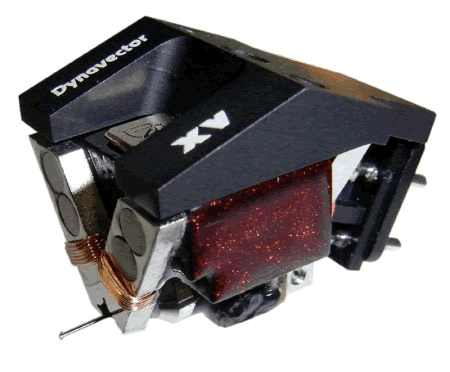
Description:
In 1999 Dynavector released the revolutionary DRT XV-1 stereo cartridge that pioneered the unique topology that included 8 Alnico magnets, magnetically stable front yokes, square shaped front armature within the rather spectacular deep “v” shaped front elevation.
Combined with Dynavector’s patented “Flux Damping” this cartridge quickly became the worldwide benchmark for music lovers and the audio press alike.
The subsequent flagship design for Dynavector the XV-ls released in 2002 refined and improved the technology. Retaining the patented Flux Dumping but included the magnetically stable front yoke with the unique square shaped aperture and improved magnetic equalizing component, all encompassed in an African Ebony body to provide further stability for the magnetic components.
First inspection of the new DV XV-lt reveals that although it is unmistakenly Dynavector, the body beautiful is Urushi lacquered over a precision machined component of heat treated bamboo that has been assiduously selected for both design, elegance and acoustic performance.
Dynavector’s patented Flux Damping process has been retained in concert with new ground breaking innovations that will quickly establish the XV-lt as not only the Dynavector flagship but set the contemporary standards in analog music reproduction.
Technology abounds within the XV-lt but the Dynavector “raison d’etre” is making the technology invisible and allowing the music to emerge like never before.
A silky smoothness is added to the musical reality which the XV cartridges have previously exhibited and as a result each instrument, performer or group is clearly imaged with a warm and rich presence. Dynavector believe that this emotive musical experience cannot be achieved by a digital source and with the XV-lt they have created a “Super Analog World”.
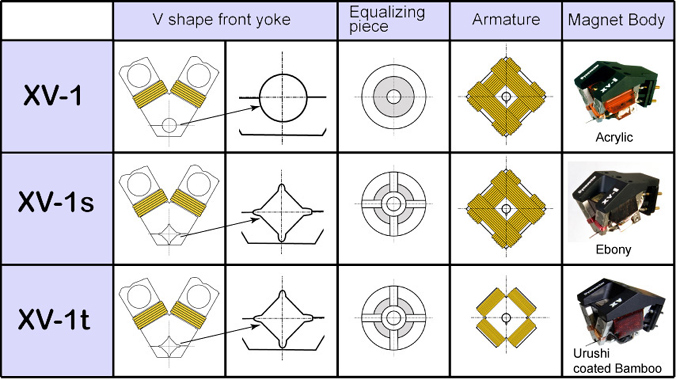
Principal Improvements
- The unique square shaped armature manufactured from a carefully selected material that is both corrosion resistant and impervious to age deterioration.
- 16 micron coil windings that only Dynavector can manufacture are wound around square shaped armature to match the square shaped hole in front yoke.
- Alnico column magnets to stabilize the magnetic circuits and increase linearity of the magnetic distribution within the air gap.
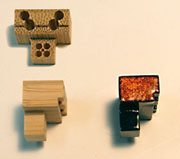
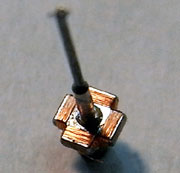
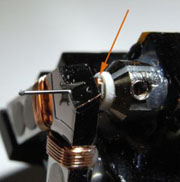
Other features
- Exclusive Walnut case.
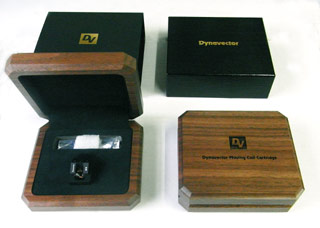
Construction
